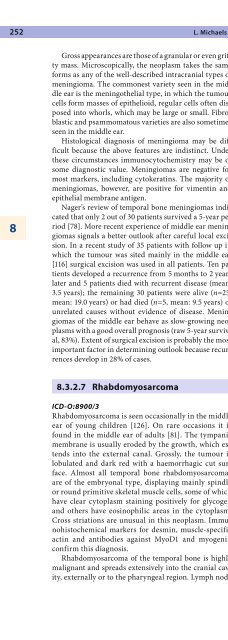Pathology of the Head and Neck
Pathology of the Head and Neck
Pathology of the Head and Neck
- No tags were found...
You also want an ePaper? Increase the reach of your titles
YUMPU automatically turns print PDFs into web optimized ePapers that Google loves.
252 L. Michaels8Gross appearances are those <strong>of</strong> a granular or even grittymass. Microscopically, <strong>the</strong> neoplasm takes <strong>the</strong> sameforms as any <strong>of</strong> <strong>the</strong> well-described intracranial types <strong>of</strong>meningioma. The commonest variety seen in <strong>the</strong> middleear is <strong>the</strong> meningo<strong>the</strong>lial type, in which <strong>the</strong> tumourcells form masses <strong>of</strong> epi<strong>the</strong>lioid, regular cells <strong>of</strong>ten disposedinto whorls, which may be large or small. Fibroblastic<strong>and</strong> psammomatous varieties are also sometimesseen in <strong>the</strong> middle ear.Histological diagnosis <strong>of</strong> meningioma may be difficultbecause <strong>the</strong> above features are indistinct. Under<strong>the</strong>se circumstances immunocytochemistry may be <strong>of</strong>some diagnostic value. Meningiomas are negative formost markers, including cytokeratins. The majority <strong>of</strong>meningiomas, however, are positive for vimentin <strong>and</strong>epi<strong>the</strong>lial membrane antigen.Nager’s review <strong>of</strong> temporal bone meningiomas indicatedthat only 2 out <strong>of</strong> 30 patients survived a 5-year period[78]. More recent experience <strong>of</strong> middle ear meningiomassignals a better outlook after careful local excision.In a recent study <strong>of</strong> 35 patients with follow up inwhich <strong>the</strong> tumour was sited mainly in <strong>the</strong> middle ear[116] surgical excision was used in all patients. Ten patientsdeveloped a recurrence from 5 months to 2 yearslater <strong>and</strong> 5 patients died with recurrent disease (mean,3.5 years); <strong>the</strong> remaining 30 patients were alive (n=25,mean: 19.0 years) or had died (n=5, mean: 9.5 years) <strong>of</strong>unrelated causes without evidence <strong>of</strong> disease. Meningiomas<strong>of</strong> <strong>the</strong> middle ear behave as slow-growing neoplasmswith a good overall prognosis (raw 5-year survival,83%). Extent <strong>of</strong> surgical excision is probably <strong>the</strong> mostimportant factor in determining outlook because recurrencesdevelop in 28% <strong>of</strong> cases.8.3.2.7 RhabdomyosarcomaICD-O:8900/3Rhabdomyosarcoma is seen occasionally in <strong>the</strong> middleear <strong>of</strong> young children [126]. On rare occasions it isfound in <strong>the</strong> middle ear <strong>of</strong> adults [81]. The tympanicmembrane is usually eroded by <strong>the</strong> growth, which extendsinto <strong>the</strong> external canal. Grossly, <strong>the</strong> tumour islobulated <strong>and</strong> dark red with a haemorrhagic cut surface.Almost all temporal bone rhabdomyosarcomasare <strong>of</strong> <strong>the</strong> embryonal type, displaying mainly spindleor round primitive skeletal muscle cells, some <strong>of</strong> whichhave clear cytoplasm staining positively for glycogen<strong>and</strong> o<strong>the</strong>rs have eosinophilic areas in <strong>the</strong> cytoplasm.Cross striations are unusual in this neoplasm. Immunohistochemicalmarkers for desmin, muscle-specificactin <strong>and</strong> antibodies against MyoD1 <strong>and</strong> myogeninconfirm this diagnosis.Rhabdomyosarcoma <strong>of</strong> <strong>the</strong> temporal bone is highlymalignant <strong>and</strong> spreads extensively into <strong>the</strong> cranial cavity,externally or to <strong>the</strong> pharyngeal region. Lymph node<strong>and</strong> bloodstream metastases frequently develop in <strong>the</strong>sepatients.8.3.2.8 Metastatic CarcinomaMetastasis <strong>of</strong> malignant neoplasms to <strong>the</strong> temporal boneincluding <strong>the</strong> middle ear is not uncommon. The breast is<strong>the</strong> commonest primary source <strong>of</strong> metastatic tumours,followed by lung, kidney, stomach, larynx <strong>and</strong> cutaneousmalignant melanoma [43, 48]. Two distinct modes<strong>of</strong> spread may be involved in bringing <strong>the</strong> neoplasmsfrom <strong>the</strong>ir primary sites to <strong>the</strong> middle ear: (a) alongvascular channels in <strong>the</strong> petrous bone (<strong>the</strong>se convey tumourdeposits to <strong>the</strong> temporal bone from distant sites),<strong>and</strong> (b) along nerves emanating from <strong>the</strong> internal auditorymeatus into <strong>the</strong> labyrinthine structures <strong>and</strong> bone.In this way, tumours reaching <strong>the</strong> meninges may spreadinto <strong>the</strong> temporal bone. In addition, direct spread maybring tumours into <strong>the</strong> ear from primary sites in areasadjacent to <strong>the</strong> temporal bone.8.4 Inner Ear8.4.1 Bony Labyrinth8.4.1.1 OtosclerosisOtosclerosis is a disease <strong>of</strong> <strong>the</strong> bony labyrinth, which,by involvement <strong>and</strong> fixation <strong>of</strong> <strong>the</strong> stapes footplate,leads to severe conductive hearing loss. Otosclerosishas some features <strong>of</strong> a hereditary disease, but its geneticsstill remain incompletely elucidated. Ultrastructural<strong>and</strong> immunohistochemical evidence for measles virus<strong>and</strong> isolation <strong>and</strong> identification <strong>of</strong> DNA <strong>and</strong> RNA sequences<strong>of</strong> that virus have been found in otosclerotictissue [18].Otosclerosis usually affects both ears symmetrically.The disease process is probably confined to <strong>the</strong> temporalbone. The pink swelling <strong>of</strong> otosclerosis may sometimeseven be detected clinically through a particularlytransparent tympanic membrane as a well-demarcated<strong>and</strong> pink focus near <strong>the</strong> promontory. A characteristictranslucency <strong>of</strong> bone adjacent to <strong>the</strong> cochlea <strong>and</strong> anteriorto <strong>the</strong> footplate is identified on a CT scan.The lesion always commences in <strong>the</strong> otic capsuletissue anterior to <strong>the</strong> footplate <strong>of</strong> <strong>the</strong> stapes. In thisposition it does not produce symptoms. These occurwhen <strong>the</strong> otosclerosis invades <strong>the</strong> adjacent stapes footplate<strong>and</strong> produces fixation <strong>of</strong> that structure <strong>and</strong> thusconductive hearing loss. It later spreads widely in <strong>the</strong>otic capsule <strong>and</strong> may involve <strong>the</strong> round window ligament.Blood vessels are prominent <strong>and</strong> evenly dis-








